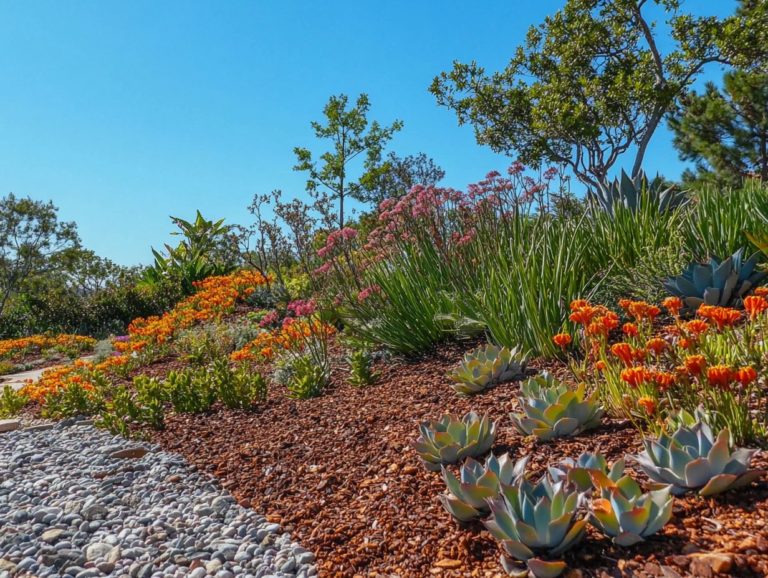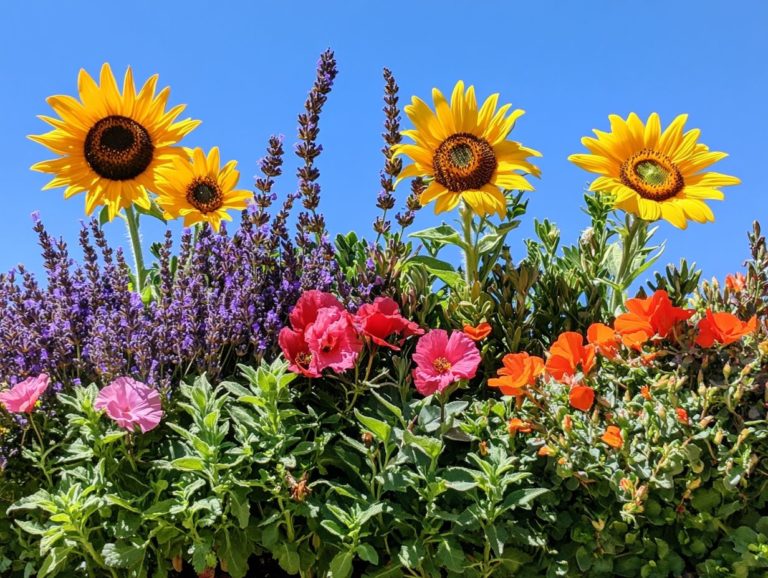5 Essential Tools for Drought-Resistant Gardening
In a time when climate change and water scarcity weigh heavily on our minds, creating a drought-resistant garden is essential.
This article delves into five pivotal tools that will empower you to nurture a flourishing garden while conserving water and showcasing breathtaking plants.
By carefully selecting drought-resistant flora, implementing efficient irrigation systems, and utilizing moisture monitoring techniques, you can embrace sustainable gardening practices that truly make a difference.
Start using these innovative strategies today to save water and transform your gardening experience!
Contents
- Key Takeaways:
- 1. Drought-Resistant Plants
- 2. Mulch
- 3. Drip Irrigation System
- 4. Rain Barrels
- 5. Soil Moisture Meter
- Why Is Drought-Resistant Gardening Important?
- Frequently Asked Questions
- What are the five essential tools for drought-resistant gardening?
- How does a drip irrigation system help with drought-resistant gardening?
- Why is mulch important for drought-resistant gardening?
- What is a rainwater harvesting system and how does it benefit drought-resistant gardening?
- How can a soil moisture meter help with drought-resistant gardening?
- What types of plants are considered drought-resistant and why?
Key Takeaways:

- Choose drought-resistant plants: Enjoy a low-maintenance, water-efficient garden.
- Use mulch: It helps retain soil moisture and suppresses weed growth, making it essential for drought-resistant gardening.
- Install a drip irrigation system: This delivers water directly to the roots, minimizing waste and promoting plant growth in dry conditions.
1. Drought-Resistant Plants
Drought-resistant plants are crucial for nurturing a sustainable garden, especially in areas that may face water scarcity. To support their growth, consider implementing 5 essential tools for soil conservation. These hardy plants require minimal water and thrive without constant irrigation, making them a smart choice for environmentally conscious gardeners.
Consider incorporating plants like Creeping Thyme and Coneflower into your low-water garden. Both showcase impressive drought resilience. Creeping Thyme features lush green foliage and a delightful aroma, flourishing in dry conditions while effectively reducing soil erosion.
The Coneflower is renowned for its stunning blooms that need little water and attract pollinators, enriching the biodiversity of your garden. These plants also promote beneficial mycorrhizal relationships partnerships between fungi and plant roots that enhance nutrient uptake and support overall plant health.
By using smart irrigation techniques and selecting resilient species, you can cultivate a landscape that thrives even in challenging conditions.
2. Mulch
Mulch is essential for water conservation and soil health. It offers a protective layer that minimizes evaporation and maintains consistent moisture levels in your garden, playing a key role in any water-wise gardening strategy.
You have various mulch options available. Organic materials like wood chips, straw, and grass clippings help retain moisture while enriching the soil with nutrients, enhancing its structure and fertility as they break down. This also keeps pesky weeds at bay.
Inorganic choices such as gravel and landscape fabric effectively regulate temperature fluctuations and provide a durable barrier against unwanted growth. When you combine both types of mulch with organic fertilizers, you create a harmonious environment that boosts overall soil health, fostering a thriving ecosystem that supports robust plant growth and resilience.
3. Drip Irrigation System
Implementing a drip irrigation system is an excellent strategy for ensuring water-efficient irrigation in your sustainable garden. This method delivers water directly to the roots of your plants, significantly reducing water waste while promoting robust growth.
This method uses a network of tubing and emitters that meticulously control the flow of water, allowing for precise application to each individual plant. Unlike traditional watering practices, which often lead to evaporation and runoff, drip irrigation targets the root zone where hydration is essential.
Organizations like TreePeople and Rain Bird advocate for these innovative irrigation solutions, frequently providing valuable resources and guidance for your installation and maintenance needs.
This system is particularly well-suited for drought-resistant plants, making it an ideal choice for arid regions where water conservation is paramount.
4. Rain Barrels

Rain barrels are a great solution for water conservation. They collect and store rainwater, which you can use for irrigation during dry spells. This reduces your reliance on municipal water sources.
These barrels capture runoff from your rooftop through gutters and downspouts, channeling it into a storage container for future use. Installation is straightforward: position the barrel beneath a downspout, ensuring it’s aligned for best water flow.
For gardening enthusiasts like you, rainwater is not just a free resource; it’s also beneficial for plants. Naturally soft and free of chemicals found in tap water, it promotes healthier plant growth.
Using collected rainwater aligns with sustainable practices, especially in drought-prone areas. It allows you to cultivate your garden while conserving valuable water resources.
5. Soil Moisture Meter
A soil moisture meter is essential for gardeners dedicated to water-wise gardening. This handy device helps you monitor soil moisture levels accurately, ensuring your plants receive just the right amount of water.
With real-time data on the moisture content in your soil, you can make informed decisions about when to water. This leads to more efficient irrigation practices.
Using such a meter conserves precious water resources and encourages healthier plant growth. It helps prevent issues like root rot that arise from excessive watering.
By understanding the specific moisture needs of different plants, you can adopt a tailored approach to irrigation. This ensures your plants thrive while minimizing waste, making your gardening efforts both sustainable and fruitful.
Why Is Drought-Resistant Gardening Important?
Drought-resistant gardening is crucial in today’s climate, championing water conservation in areas facing extended dry spells. To achieve this, consider following these tips for maintaining your drought garden, which cultivate a sustainable garden that enhances plant health while fostering wildlife habitats and supporting the ecosystem.
By embracing these techniques, you can create vibrant landscapes that require minimal irrigation, following 5 tips for building a water-wise garden. This approach alleviates pressure on invaluable water resources and encourages the growth of resilient native plants.
These native plants attract diverse pollinators and beneficial insects, enriching your garden’s vitality. You can further boost your garden’s health by using organic practices like composting and mulching.
These practices nourish the soil, improve moisture retention, and reduce reliance on chemical fertilizers. Transitioning to drought-resistant gardening and using the top tools for caring for drought plants aligns ecological health with your personal sustainability efforts.
What Are the Benefits of Using Drought-Resistant Plants?
Incorporating drought-resistant plants into your garden offers various advantages. You will experience reduced water consumption and lower maintenance requirements.
These resilient plants, such as succulents, lavender, and agave, thrive in arid environments. They store moisture in their leaves and roots, enabling them to prosper even in drought-prone areas.
By selecting these drought-resistant varieties, you conserve water and enrich local biodiversity by creating habitats for pollinators. Whether tending to an urban balcony or a sprawling rural landscape, you will enjoy less frequent watering.
Ultimately, this leads to a more eco-friendly garden that flourishes, even in adverse conditions. To enhance your knowledge, check out 5 recommended books on drought gardening and start your journey toward drought-resistant gardening today to help save our planet’s precious water resources!
How Can Mulch Help Conserve Water in Gardening?

Mulch is a must-have for every gardener aiming for sustainability! It acts as a protective barrier that conserves water by reducing evaporation, maintaining soil temperature, and enhancing overall soil health.
By creating a shield that slows moisture loss, mulch becomes invaluable during hot, dry seasons when plants are vulnerable to stress. Organic mulches like wood chips, straw, and grass clippings not only insulate the ground but also decompose over time, enriching the soil with essential nutrients. This natural breakdown fosters beneficial microorganisms, crucial for soil health.
Although inorganic options like rubber or gravel can also be effective, they won t improve soil quality. Incorporating mulch into your gardening strategy promotes water conservation and nurtures a vibrant ecosystem below the surface.
What Are the Advantages of Using a Drip Irrigation System?
A drip irrigation system offers very effective water-saving benefits, providing targeted delivery to plant roots and significantly reducing evaporation. It s a perfect choice for anyone looking to cultivate a sustainable garden.
This innovative method not only conserves water but also leads to significant cost savings over time. By minimizing water waste, you ll enjoy lower utility bills. Unlike traditional irrigation methods that waste water across large areas, drip irrigation focuses on the specific needs of your plants.
This system enhances the growth and health of your plants while aligning with your commitment to environmental stewardship. By reducing runoff and promoting deep root development, drip irrigation is key to sustainable gardening practices, ensuring you utilize resources wisely.
How Can Rain Barrels Help with Drought-Resistant Gardening?
Rain barrels are invaluable for enhancing drought-resistant gardening. They collect and store rainwater for later use, playing a significant role in water conservation.
These barrels capture runoff from your roof, directing it into accessible containers that nourish your plants, even during dry spells. Incorporating rain barrels into your gardening routine lessens the impact of water scarcity and promotes sustainable habits.
Utilizing collected rainwater can lower your water bills, making your gardening efforts both eco-friendly and financially savvy. The ease of installation and maintenance encourages you to engage in this practice and deepen your connection with resource management.
Why Is Monitoring Soil Moisture Important for Drought-Resistant Gardening?
Monitoring soil moisture is crucial for success in drought-resistant gardening. To learn more about effective practices, check out this guide on how to get started with drought-resistant gardening. It helps you determine when and how much to water, ensuring your plants receive optimal moisture without overwatering.
By using techniques to measure moisture levels, you can boost plant growth while minimizing water usage. One effective method is using soil moisture meters, which measure how much water is in the soil. Visual inspections, such as checking the soil’s coloration or the condition of your plants, can also guide your watering decisions.
Don’t underestimate traditional methods like the finger test ; simply feeling the soil s texture can reveal moisture levels without any tools. These strategies refine your watering schedules and irrigation practices, leading to healthier plants and efficient water conservation.
Frequently Asked Questions

What are the five essential tools for drought-resistant gardening?
The five essential tools for drought-resistant gardening are:
- A drip irrigation system
- Mulch
- A rainwater harvesting system
- A soil moisture meter
- Drought-resistant plants
How does a drip irrigation system help with drought-resistant gardening?
A drip irrigation system is a method that slowly waters plants directly at their roots. This approach reduces water waste and ensures that plants receive necessary moisture without the risk of overwatering.
Why is mulch important for drought-resistant gardening?
Mulch helps retain moisture in the soil. This reduces the amount of water needed for plants to thrive. It also suppresses weeds that compete for resources.
What is a rainwater harvesting system and how does it benefit drought-resistant gardening?
A rainwater harvesting system is a setup that collects and stores rainwater. This collected water can be used to nourish plants during dry periods, reducing reliance on municipal water sources, which may become limited during droughts.
How can a soil moisture meter help with drought-resistant gardening?
A soil moisture meter measures the moisture level in the soil. This allows gardeners to water plants only when necessary, preventing overwatering and ensuring that plants receive the right amount of water for their needs.
What types of plants are considered drought-resistant and why?
Drought-resistant plants are amazing survivors! They thrive in dry conditions, making them perfect for water-wise gardening. These plants often have features such as deep root systems, thick waxy leaves, or the ability to store water in their leaves or stems. As a result, they require less water and can withstand long periods of drought.
Ready to make your garden drought-proof? Start with these essential tools today!






